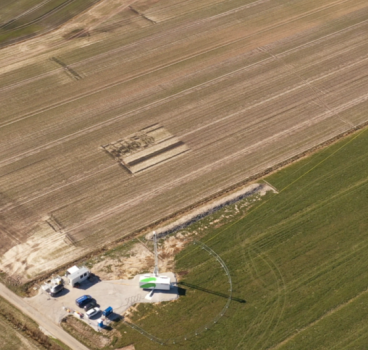How geothermal energy is reshaping construction
Geothermal energy – a vast reservoir of natural heat stored within the core of our planet - holds the key to transforming the construction industry, making buildings more sustainable, cost-effective, and environmentally friendly. writes John Ridgeway.
At a time of climate uncertainty, geothermal energy offers a compelling proposition for the future of construction. Unlike fossil fuels, it is a renewable resource with minimal greenhouse gas emissions. Simply by integrating geothermal systems into buildings, significantly reduces reliance on traditional heating and cooling methods, leading to a smaller environmental footprint – so the potential is vast.
It’s a movement which is gaining momentum worldwide, with ground source heat pumps contributing to that growth by offering superior efficiency compared to traditional heating and cooling systems. These are achieving significant energy savings, translating to lower operating costs for building owners and occupants.
The geothermal energy market is experiencing steady growth, driven by increasing concerns about greenhouse gasses and the need for clean energy sources. However, no one is entirely sure what the growth will be. As of 2024, estimates for the global geothermal energy market size vary slightly depending on the source.
According to “MarketsandMarkets” it was worth $6.6 Billion in 2021 and projected to reach $9.4 billion by 2027 (CAGR of 5.9%) Source: https://www.marketsandmarkets.com/Market-Reports/geothermal-energy-market-205152720.html]
Mordor Intelligence claim the market size is expected to reach $15.68 billion in 2024 (installed base in terms of gigawatts) Source: https://www.mordorintelligence.com/industry-reports/geothermal-energy-market and Straits Research say the global geothermal power market was valued at USD 7.87 billion in 2022 and is estimated to reach USD 11.79 billion by 2031 (CAGR of 4.6%) Source: https://www.marketresearchfuture.com/reports/geothermal-power-market-8731]
Whatever statistics you believe, all sources point towards a positive growth trajectory for the geothermal energy market, based on the growing awareness of climate change and the need for clean energy sources, which are driving demand.
Many governments are also offering incentives like tax breaks and feed-in tariffs to encourage geothermal energy development and advancements in drilling technology and enhanced geothermal systems (EGS), which are expanding the potential for geothermal use in more locations.
One thing is certain, however. Geothermal systems offer a reliable and consistent source of both heating and cooling, creating comfortable indoor environments throughout the year, regardless of seasonal fluctuations. Unlike solar or wind energy, which are weather-dependent, geothermal energy is a baseload source of power. It's not affected by weather conditions, offering a reliable and resilient option for heating and cooling buildings.
Despite its potential, geothermal energy faces some challenges. The upfront costs of drilling geothermal wells can be high, depending on where you live. Less so where the technology is most readily available in areas with naturally occurring geothermal resources such as Iceland. Additionally, exploration and development require careful environmental considerations to minimise any potential impact on ecosystems.
However, significant strides are being made to address these challenges. Technological advancements are leading to more cost-effective drilling methods, and research into enhanced geothermal systems (EGS) is expanding the potential for geothermal use in areas with less readily accessible heat sources.
This might, of course, sound all 21st century technology, but our connection with geothermal energy stretches back millennia. Early civilisations, from the Romans with their sophisticated hypocaust heating systems to the ingenious hot spring bathing cultures of Japan, used the Earth's natural warmth for bathing and space heating. However, the large-scale harnessing of geothermal energy is a relatively recent phenomenon.
The 19th century saw the first documented geothermal power plant in Italy, but it wasn't until the 20th century, with advancements in drilling technology, that geothermal energy truly began to gain traction. Today, it serves as a significant source of clean energy in many countries, particularly those located near tectonic plate boundaries where the Earth's heat is closer to the surface.
Geothermal energy originates from the Earth's core, where temperatures can reach a scorching 6,000 degrees Celsius. This heat radiates outwards, heating the surrounding rock and fluids. Geothermal power plants tap into this heat by drilling deep wells into the Earth's crust. The hot water or steam brought to the surface is then used to generate electricity through turbines.
The Hellisheidi Power Plant in Iceland is a good example. This colossal geothermal complex in Iceland boasts the highest capacity for geothermal electricity generation in Europe, supplying a significant portion of the country's power needs.
The Klamath Falls District Heating System in Oregon, established in the early 20th century, is one of the oldest and largest operating district heating systems in the United States. It uses geothermal resources to provide heat and hot water to over 4,000 homes and businesses in the city.
The Eden Project in Cornwall, England, uses a ground source heat pump system to maintain a warm and humid environment for its diverse plant life, showcasing the versatility of geothermal technology beyond traditional heating applications.
But geothermal energy isn't just about electricity generation. We can also use it directly for space heating and hot water needs through ground source heat pumps (GSHPs). These innovative systems act like a giant refrigerator in reverse, transferring heat from the constant temperature of the Earth into a building during the winter and extracting heat from the building for disposal into the ground during the summer.
As we move towards a future focused on sustainability and environmental responsibility, we can see that thermal energy offers a powerful and promising solution for the construction industry.
By embracing these technologies, we can create buildings that are not only energy-efficient but also comfortable for occupants and kind to the planet. The future of construction lies in harnessing the Earth's embrace and working in harmony with the natural world. Geothermal energy stands as a crucial tool in this journey, paving the way for a more sustainable future.
Sources:
https://www.irena.org/Publications/2023/Feb/Global-geothermal-market-and-technology-assessment,
https://www.energystar.gov/, https://www.energy.gov/eere/buildings/thermal-energy-storage)
https://www.lovegeothermal.org/, https://geothermal.org/, https://orkustofnun.is/en)
Additional Blogs

Wind-power for cranes – a construction game changer?
Wind energy, a clean and renewable resource, is emerging as a game-changer for the construction industry – with innovations that continue to surprise. By harnessing the power of the wind,...
Read moreAre empty desks a construction opportunity?
The COVID-19 pandemic fundamentally altered the way we are employed. With millions transitioning to remote work, office buildings across the Western world stand eerily empty, sparking a critical...
Read more

How new regulations are reshaping the construction industry
The construction industry has long been known for its focus on cost. Traditionally, the lowest bidder has nearly always secured the project, leading to concerns about cutting corners and compromising...
Read more